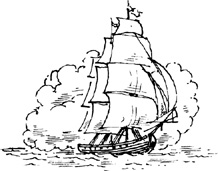
The poem in Chapter 12 is ‘The Price of Experience’ by William Blake. Although it was first published in The Writings of William Blake (eds Edwin J. Ellis and William Butler Yeats, 1893) it was written in 1797, so it’s not impossible to imagine that someone who knew Blake personally, a character similar to Tom Shepherd, in fact, would have seen it.
Parts of the conversations in Chapter 7 and Chapter 10 were inspired by passages in The British Tar in Fact and Fiction by Commander Charles N. Robertson (Harper and Brothers, London, 1911). These capture the language of the era so wonderfully I did not want to change them beyond recognition.
Although I was determined to base the characters and their circumstances firmly in historic reality, Powder Monkey is first and foremost a novel rather than a history book. For any reader wanting to find out more about the real history here, I can recommend any of the following:
Jack Aubrey Commands: An Historical Companion to the Naval World of Patrick O’Brian by Brian Lavery (Conway Maritime Press, London, 2003)
The Seafarers: Fighting Sail by A.B.C. Whipple and the editors of Time-Life Books (Caxton Publishing Group, London, 2004)
Hornblower’s Navy: Life at Sea in the Age of Nelson by Steve Pope (Orion Books, London, 1998)
Life in Nelson’s Navy by Dudley Pope (Chatham Publishing, London, 1981)
These are all accessible, highly readable books, which should be available in most public libraries. The first three are also full of fascinating and colourful illustrations – some from the era, others artwork recreations.
If you want to dig a little deeper you could try:
Nelson’s Navy: The Ships, Men and Organisation 1793–1815 by Brian Lavery (Conway Maritime Press, London, 1989)
The Wooden World: An Anatomy of the Georgian Navy by N.A.M. Rodger (Collins, London, 1986)
Sea Life in Nelson’s Time by John Masefield (Leo Cooper, 2002 – first published 1905)
The Star Captains: Frigate Command in the Napoleonic Wars by Tom Wareham (Chatham Publishing, London, 2001)
The Sea Warriors by Richard Woodman (Constable Publishers, London, 2001)
The Merchant Navy by Captain A.G. Course (Frederick Muller, London, 1963)
Real enthusiasts could trawl the second-hand book shops for:
The British Tar in Fact and Fiction by Commander Charles N. Robertson (Harper and Brothers, London, 1911)
Memoirs of a Seafaring Life by William Spavens (facsimile edition published by the Folio Society, London, 2004 – originally published in 1796)
Books aside, there’s nothing like a trip to a real fighting ship from the era to get a flavour of what life must have been like aboard. British readers can visit the frigate HMS Trincomalee in Hartlepool – upon which the Miranda is closely based (see www.hms-trincomalee.co.uk), and Nelson’s famous flagship HMS Victory in Portsmouth. The Victory’s excellent website (www.hms-victory.com) includes a list of all 820 men serving on the ship during the Battle of Trafalgar, together with their age, nationality and position.
North American readers can visit another frigate from the era, USS Constitution, berthed in Boston, Massachusetts (see www.ussconstitution.navy.mil).
And finally. . .
Peter Weir’s Master and Commander film (2003), starring Russell Crowe as Patrick O’Brian’s character Captain Jack Aubrey, painstakingly recreates a frigate similar to HMS Miranda. It’s a rip-roaring action adventure too!